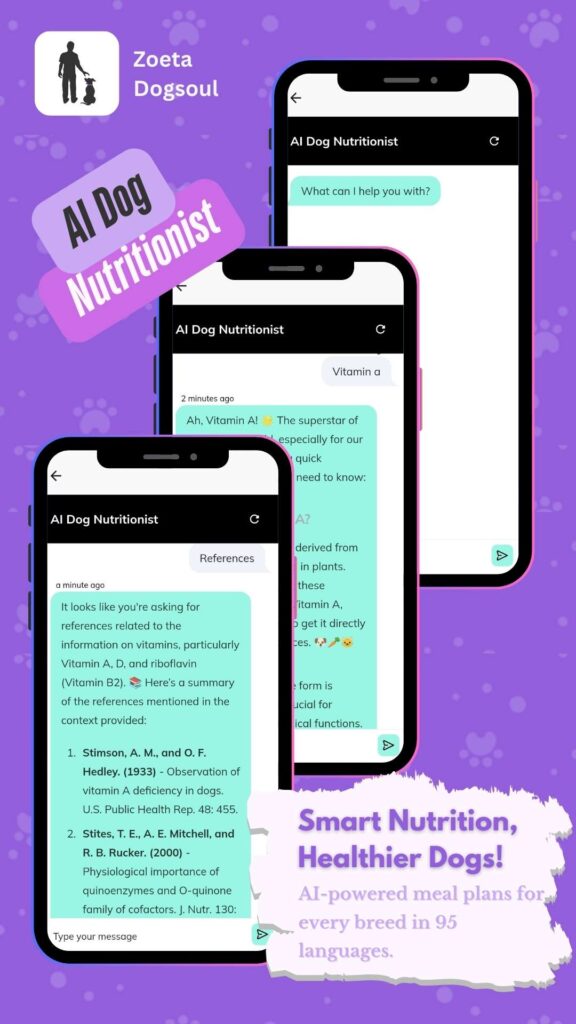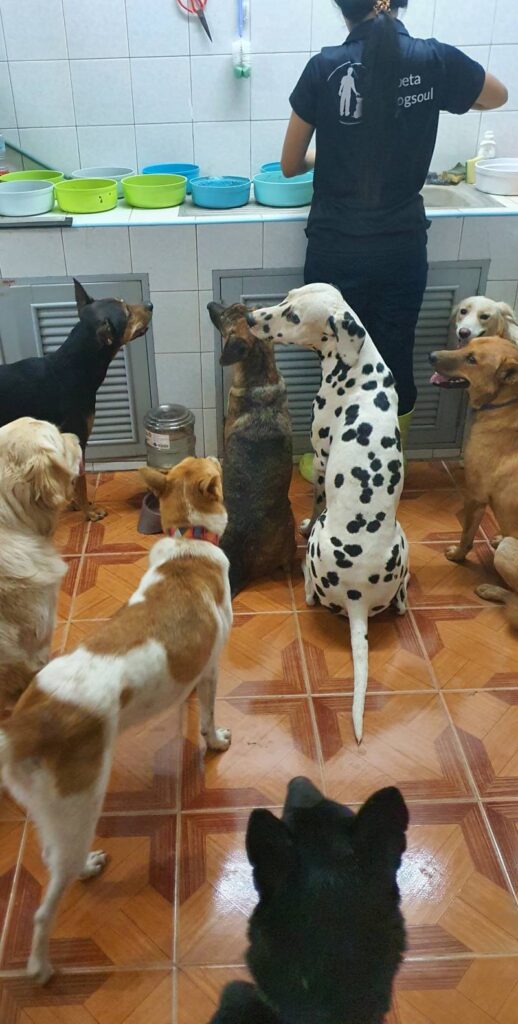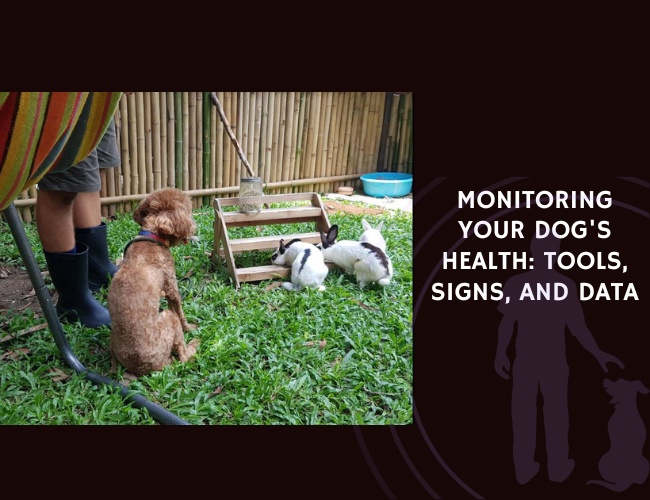Introduction to Canine Health Monitoring
Why proactive monitoring matters
Taking care of your dog’s health isn’t just about treating sickness—it’s also about catching issues early. Proactive health monitoring helps you notice small changes that could signal bigger problems down the road. This approach can lead to a longer, happier life for your dog by allowing you to address concerns before they become severe.
You don’t need to be a veterinarian to make a big difference. Paying close attention to your dog’s habits and body can reveal early clues about pain, illness, or stress. When you combine your daily observations with regular veterinary care and modern technology, you’ll be well-equipped to support your pet’s wellbeing.
Blending veterinary science, technology, and behavior
Great canine health monitoring brings together three key pieces:
- Veterinary science: Your vet provides expert examinations, diagnostic testing, and baseline data for what’s normal for your individual dog.
- Technology: Wearable devices can track activity, sleep, heart rate, and temperature. Health apps help you store medical records and note symptoms. Even home cameras let you review your dog’s behavior when you’re away.
- Behavioral observation: Subtle changes in energy, appetite, playfulness, or social interaction are often the first signals of a problem.
By combining these, you get the most complete picture of your dog’s health. The goal isn’t to replace professional advice, but to give you reliable daily insights and help your veterinarian make faster, more accurate diagnoses.
The value of early detection
Small signals matter. A slight limp, a change in play, or new bathroom habits might seem minor, but together they can add up to early signs of health issues. Wearable devices can catch drops in activity or sleep disruptions, while health apps make it easier to notice changes over time.
Addressing problems at the first sign often leads to gentler treatments, lower stress, and better outcomes for your pet. Early intervention can also mean fewer vet visits in the long run and a higher quality of life for your furry companion.
Every dog is unique, so your monitoring routine will grow and adapt just like your dog does.
Understanding Vital Signs and Physical Indicators
Keeping an eye on your dog’s vital signs is an essential part of proactive pet care. These simple checks, done at home, give valuable insight into your dog’s physical well-being and can help catch health issues early.
Knowing the Normal Ranges
Dogs have basic vital signs, much like humans. Knowing what’s normal can help you spot problems before they become serious.
- Heart rate: 60-160 beats per minute (bpm), with smaller breeds usually having a faster rate.
- Respiratory rate: 10-30 breaths per minute.
- Temperature: 100.5–102.5°F (38–39.2°C).
- Gum color: pink and moist.
- Capillary refill time (CRT): less than 2 seconds.
Keep in mind, normal ranges can vary by breed, size, and age. It’s a good idea to ask your veterinarian for your own dog’s baseline values.
Measuring Vital Signs at Home
Being able to measure these signs at home is a great way to stay on top of your dog’s health. Here’s how:
- Heart rate: Use a stethoscope for best results. Gently place it on the left side, just behind your dog’s elbow. Count beats for 15 seconds and multiply by four.
- Respiratory rate: Watch your dog’s chest or belly rise and fall. Count breaths for 15 seconds, then multiply by four. Make sure your pet is calm for accuracy.
- Temperature: Use a lubricated rectal thermometer for precision. Hold your dog gently but firmly.
- CRT: Press your dog’s gum gently and release. Time how long the pink color returns. Under 2 seconds is healthy.
Spotting Signs of Distress
Physical warning signs should never be ignored. These may include:
- Rapid, weak, or irregular heartbeat.
- Labored or open-mouth breathing.
- Blue, pale, white, or very red gums.
- Lethargy, shivering, or overheating.
- CRT longer than 2 seconds.
These symptoms can mean your dog needs veterinary care quickly. 🐶
Monitoring vital signs at home builds your confidence and strengthens your bond with your furry friend. Whenever you spot changes from their baseline, follow up with your veterinarian to keep them healthy and happy.
Next, let’s explore how your dog’s behavior can act as an early warning system for health concerns.

Behavioral Red Flags: What Your Dog’s Actions Tell You
Spotting Changes in Daily Routines
Understanding your dog’s usual routines can help you catch early health issues. Sudden shifts in appetite or thirst stand out as major red flags. If your dog eats or drinks much more or less than normal, it could mean they’re dealing with illness, pain, or dental problems. Keep an eye out for extra treats being ignored or a water bowl emptying faster than usual.
Energy levels are a big clue as well. If your pup is unusually tired, sleeps a lot, or suddenly becomes restless or hyperactive, these changes might signal underlying conditions. A simple walk turning into a struggle, or playful dogs skipping their favorite games, deserve extra attention.
Watch your dog’s elimination habits, too. Accidents in the house, more frequent bathroom breaks, or changes in feces consistency can hint at urinary tract infections, stomach issues, or other health concerns. Quick attention to these signs helps prevent bigger problems.
Spotting Signs of Pain or Illness Early
Dogs try to hide pain, but subtle actions reveal discomfort. Limping, stiffness after resting, or slow movements show joint pain or injury. Pay attention to their voice—whining, yelping, or odd noises often mean something hurts.
Posture changes—like a hunched back or an unwillingness to jump—can also be red flags. Grooming habits matter, too. Excessive licking, chewing, or scratching in a specific spot might signal allergies, skin irritation, or pain. A sudden loss of interest in play or isolating from family can be signs of chronic illness or discomfort.
Social Behavior Tells a Story
Changes in how your dog interacts with people and other pets are important. Withdrawal, increased aggression, or non-stop barking may point to pain, anxiety, or aging-related cognitive changes. Even subtle shifts, such as avoiding affection or new fears, can hold health clues.
Staying in tune with your dog’s behaviors and noting changes is vital for early intervention. While at-home observation is powerful, it works best when combined with regular checkups and honest communication with your veterinarian. 🤝
Next, exploring the modern tools available can help you further enhance your ability to monitor your dog’s well-being at home.
Modern Monitoring Tools for Home Use
Staying a step ahead when it comes to your dog’s health has never been easier. Thanks to handy, modern tools, you can monitor your pet’s well-being right from home. This goes beyond the basics covered previously, giving you a front-row seat to your dog’s daily patterns—even when you’re not around.
Wearable Devices: Real-Time Insights
Wearable devices are changing the way we keep tabs on our dogs. Just like fitness trackers for humans, these gadgets measure key data such as:
- Activity levels, letting you know if your dog is moving less than normal (which could mean they’re not feeling well)
- Sleep quality, flagging restlessness or too much sleep as possible warning signs
- Heart rate variability (HRV), helping you notice stress or early health problems
Brands like Fi, Whistle, and PetPace make it simple to check your dog’s data on your phone. It’s important to remember that these devices are there to inform you—they’re not a substitute for seeing the vet, but help you spot small changes worth discussing with your professional.
Health-Tracking Apps: Building Your Dog’s Health History
Health-tracking apps act like a digital diary for your dog. In these apps, you can:
- Log symptoms, medications, and vet visits
- Track weight and feeding routines
- Store records for easy sharing with your veterinarian
Over time, this creates a comprehensive health history. If your dog’s behavior changes or an emergency arises, having this information on hand makes a huge difference.
Cameras and Remote Monitors: Eyes When You’re Away
Remote cameras let you peek at your dog’s activities any time. This is especially helpful for:
- Tracking signs of separation anxiety
- Noticing unusual restlessness during the day
- Confirming if symptoms (like limping or changes in movement) persist when you’re gone
Video recordings can also help your vet see behaviors that only happen when you aren’t home.
With these tools, you’ve got valuable data to catch health issues early and keep your dog feeling their best. This groundwork helps you team up with your vet for even more thorough care.
Watch. Track. Protect.
Health Starts with Awareness
Your dog can’t say what’s wrong—but their body can. From shifts in appetite to small changes in energy, early warning signs often appear long before illness becomes obvious. Daily check-ins help you spot problems early, when they’re easier to treat.
Tech Meets Intuition
Modern tools like wearable trackers, apps, and remote cameras give you powerful insights—but your instincts still matter. When you blend real-time data with careful observation and professional checkups, you create a health safety net that truly works.



Know What’s Normal, Act on What’s Not
Every dog is different. By learning your dog’s baseline and staying consistent with monitoring, you catch subtle changes before they escalate. It’s not about paranoia—it’s about partnership. Because a healthy dog isn’t just lucky. It’s well cared for.
Professional Diagnostic and Screening Methods
Regular checkups and professional diagnostic tests are essential parts of keeping your dog healthy. While at-home tools are helpful, only veterinary professionals can perform certain tests that catch health problems early and help prevent future issues.
Why Routine Vet Visits Matter
Taking your dog to the vet regularly offers benefits you simply can’t get at home. Vets have special training, equipment, and experience to spot health issues that even the most careful owner might miss. These visits help create a health history for your dog, making it easier for you and your veterinarian to catch changes before they turn into big problems.
Common Diagnostic Tests
Every dog should have a few key tests done during regular visits:
- Blood panels check for organ function, infections, and hidden conditions like diabetes or anemia.
- Urinalysis reveals details about kidney health, urinary infections, and even early signs of some diseases.
- Fecal tests screen for intestinal parasites and digestive problems.
- Dental exams are not just about clean teeth! They actually help prevent periodontal disease, which can affect the whole body.
- Skin and mass checks help spot lumps, bumps, or strange skin changes that could signal cancer or infection.
Establishing Baseline Data
One of the most valuable things your vet does during each exam is help establish your dog’s “normal.” By tracking things like weight, vital signs, and behavior year after year, changes stand out more clearly. This baseline data is like a roadmap for your dog’s future health. Deviations—like a slow weight loss or sneaky shift in vital signs—can then trigger quick action, keeping your dog feeling its best.
Modern veterinary care uses technology and science to give your pup the best chance at a long, healthy life. Keeping up with professional screenings—alongside your at-home efforts—ensures you’re always one step ahead when it comes to your dog’s well-being. 🐶
Technology Advancements in Veterinary Care
Technology is quickly changing how we care for our dogs’ health. One of the biggest advances is the rise of telehealth services. Now, you can connect with your veterinarian from the comfort of home using video calls or messaging. This means less stress for both you and your dog, while also getting quick answers to common health questions. Telehealth can help with everything from medication updates to deciding if a trip to the clinic is needed. This convenience is a game changer for monitoring your dog’s ongoing well-being and catching health problems early.
Harnessing the Power of Artificial Intelligence
Artificial intelligence (AI) is another modern tool helping veterinarians spot health issues sooner. AI-driven analytics take large amounts of data from wearable devices and health apps. By analyzing daily activity, heart rate patterns, and sleep quality, AI can notice tiny changes that suggest something might be wrong—sometimes before you even see symptoms. For example, a sudden drop in activity level or changes in sleep could be early signs of pain or illness. This means you and your veterinarian can act faster to keep your dog healthy.
Creating a Unified Health Picture
What makes these advancements even more powerful is data integration. When all the information from wearables, health-tracking apps, and regular checkups come together, your dog’s health story becomes clearer. Your veterinarian can use this complete record to spot trends, notice changes, and make better choices for your dog’s care. This whole-picture approach helps ensure nothing is missed and every concern is addressed. It’s like giving your vet a supercharged set of tools to guide each step of your dog’s health journey.
With these tools and technology by your side, you can stay ahead of potential problems and make more confident choices for your furry friend’s care.
Breed-Specific Monitoring Considerations
Every dog is unique, and so are their health needs. Knowing which health issues your dog is prone to based on their breed can make a huge difference in catching problems early and keeping them happy and healthy. 🐶
Why Breed Matters
Some breeds are more likely to develop certain health conditions than others. This is called breed predisposition. For example, Doberman Pinschers are at higher risk for heart conditions like dilated cardiomyopathy, while Dachshunds are more likely to have back problems. By understanding these risks, you can focus your monitoring on the right warning signs and take action sooner. Regular checks tailored to your breed’s needs empower you to make proactive decisions about your pet’s care.
Tailoring Monitoring for Your Dog
Your dog’s breed should help guide your monitoring routine. Here’s how:
- Learn about breed risks: Work with your vet to identify what your dog is most at risk for.
- Watch for early symptoms: Some symptoms, like reduced activity, stiffness, or weight loss, may sneak up subtly. Pay extra attention to these signs, especially if your dog’s breed is prone to specific diseases.
- Set breed-specific baselines: Normal heart rates, temperature, and activity levels can differ between breeds. Collect this information when your dog is healthy—this helps spot changes faster.
Examples of Breed-Specific Focus
- Heart health: For breeds like Boxers and Dobermans, regular monitoring of heart rate and energy level is key.
- Joint care: Larger breeds, such as Labradors and German Shepherds, may need extra monitoring for signs of hip or elbow issues, like difficulty rising or reluctance to play.
- Back health: Dachshunds benefit from regular checks on gait or posture, catching spine issues early.
- Dental checks: Smaller breeds, like Chihuahuas and Yorkies, can develop dental disease more quickly, so frequent mouth checks are important.
By focusing your efforts on your dog’s unique risks, you’ll have a better shot at keeping them healthy. This approach, paired with observation and regular vet care, forms the backbone of truly effective monitoring.
Next, we’ll look at building a monitoring routine that fits your life and your dog’s needs.
Implementing an Effective Monitoring Routine
Creating a health monitoring routine for your dog is a fantastic way to support their overall well-being. Consistency is key—developing a simple, repeated process makes it easier to catch small problems before they turn into bigger ones. Let’s dive into how you can put this into action at home.
Building a Routine for Health Checks
Scheduling regular checks at home is a great start. Set aside specific times during the week to:
- Observe your dog’s behavior and energy levels
- Feel along their body for lumps, bumps, or sore spots
- Check their gums for healthy color and quick capillary refill
- Record their heart rate, breathing rate, and temperature using safe home methods
By writing down your dog’s normal signs and any changes, you’ll build a helpful baseline record. This makes it much easier to spot if something is off down the road.
Combining Nutrition, Training, and Environment
Health monitoring is most effective when it fits smoothly into mealtime, walks, or playtime. For example:
- Scan for changes in appetite during feeding
- Notice energy levels and gait during walks
- Watch their skin and coat condition while grooming
Training helps here, too! Teaching your dog to cooperate during health checks—like standing still or letting you look inside their mouth—can make the process calmer for both of you.
Don’t forget that your dog’s environment matters. Clean bedding, appropriate temperature, and safe play areas all contribute to better health. Changes, such as a new pet at home or adjustments in routine, may affect your dog’s behavior or well-being, so include these factors in your monitoring notes.
Working with Your Veterinarian
Consistent home monitoring is powerful, but it works best alongside professional veterinary care. Bring your notes and any wearable device data to vet visits. Discuss any unusual findings, even if they seem minor. This teamwork gives your vet more insight and helps tailor care to your dog’s unique needs.
By blending observation, day-to-day care, and collaboration with your vet, you create an environment where your dog’s health comes first—every day.
Conclusion: Empowered Pet Parenting Through Data
Building Confidence With Consistent Monitoring
Caring for your dog is a daily commitment, and thanks to data and new technology, you have more tools than ever to make informed decisions. Consistently observing your dog’s behavior, vital signs, and routines gives you a richer understanding of what’s “normal” for your pet. This foundation makes it much easier to spot early warning signs, such as reduced activity, changes in appetite, or new behaviors. Recognizing these shifts empowers you to act quickly and seek guidance, improving your dog’s quality of life and often leading to gentler treatments when needed.
The Synergy of People, Technology, and Profession
Combining hands-on observation with technology gives your dog the best chance for early detection and better health. Wearable devices, health-tracking apps, and remote monitoring cameras allow you to keep a close eye on changes in activity, sleep, or heart rate. Regularly logging these observations in an app or journal leads to a complete health picture you can share with your veterinarian. This holistic approach means you’re tracking both medical numbers and little details in your dog’s behavior that matter most.
Partnering with your veterinarian adds a professional layer. Vets use diagnostic tests—like blood panels, urinalysis, and dental exams—not only for annual checkups but also to solve new problems quickly. These screenings, paired with your at-home data, give a full and accurate picture of your dog’s needs and risks. Always remember, no gadget or checklist can replace the experience of a skilled veterinary professional.
Using Knowledge for Compassionate Care
Your dedication to consistent health monitoring pays off. It’s about more than just collecting numbers or using fancy gadgets—it’s about paying attention, asking questions, and working with experts to create a healthy, happy life for your dog. While these efforts support and enhance your pet’s well-being, they do not substitute for a veterinarian’s diagnosis or advice. For any concerns or if something feels off, always consult your vet for direct support. Your careful attention, combined with modern advancements, makes you a truly empowered pet parent. 🐾









